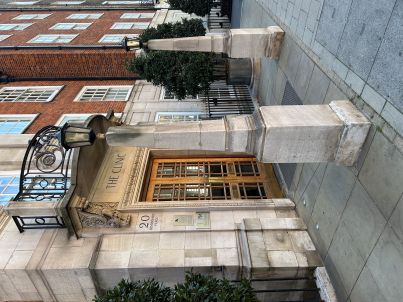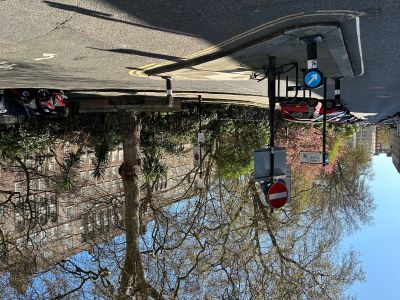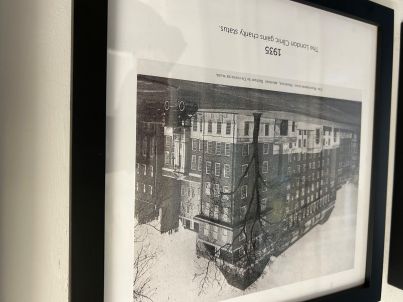
Hemingway scholars and Society members certainly are knowledgeable about the serious injuries, including several major concussions, Hemingway sustained throughout life. His 1918 war injury from an Austrian mortar shell consisted of shrapnel wounds and a concussion. Ten years later in Paris he mistook a skylight rope for the chain to flush the commode, causing the skylight to fall, cutting his forehead so badly it left a permanent scar. In summer 1944, he banged his head hard on a rock while seeking cover after the motorcycle in which he was riding came under German heavy weapons fire. And the numerous injuries he sustained from the second aircraft accident during the 1954 African safari are equally well-known. Hemingway had little or no control over these tragic accidents.
The head concussion he sustained in London only days before the Normandy invasion also has been documented by biographers; however, unlike the other accidents, what occurred in the wee small hours in London could easily have been avoided. Hemingway’s faulty or impaired judgement caused him irreparable damage: another frontal injury that, when combined with other serious mishaps, put him steadily on course from suffering what currently is termed post-concussive syndrome.1
On the evening of 24 May 1944, Ernest Hemingway accepted a party invite from Robert Capa, his close friend from Spanish Civil War days. The photographer promised one humdinger of a “drinks do” at his flat in Belgravia Square, an extremely posh area of London. Capa had secured ten bottles of Scotch, eight bottles of gin, a case of champagne and some brandy.2 As the booze flowed, the banter increased. Hemingway even organised an impromptu boxing match in Capa’s tiny kitchen. The revellers called it a night sometime between three and four o’clock in the morning of the twenty-fifth. Although it would be an an easy walk from Belgravia Square to Mayfair, Hemingway, perhaps too unfamiliar with London’s geography or simply too inebriated to bother, accepted fellow guest Dr. Peter Gorer’s offer of a ride to the Dorchester hotel.3 Hemingway should have walked. It would have taken less than thirty minutes. There would have been minimal, if any, traffic, the crossing lights would not have been operational and he could have taken a much used shortcut through Hyde Park.4

Perhaps because of roadblocks or buildings/roads damaged from bombs, Gorer, who also had imbibed too much, drove a rather circuitous north-westerly route via Lowndes Square. Navigating in black-out conditions with dimmed headlights through thick London fog, Gorer soon collided head-on into a large steel water tank positioned at one end of Lowndes Square. The accident caused Hemingway's head to bash hard against the windscreen, resulting in a concussion and deep head wound. He was bleeding heavily. The forward thrust of the impact also caused Hemingway to hit his knees against the unforgiving metal and wood of the dashboard, further injuring him.5 He was taken immediately to St. George’s Hospital a few blocks away (redeveloped recently as the luxurious Lanesborough Hotel), located at Hyde Park Corner across from Wellington Arch and the Royal Artillery World War I Memorial. Days later, after recovering from a lengthy surgery resulting in fifty-seven stitches, Hemingway was transferred a short distance to the London Clinic in Marylebone for gentle respite and quiet recovery.6

Hemingway soon found he had a more explosive and emotionally troubling issue to deal with after Martha Gellhorn’s ship docked safely in Liverpool following her harrowing, seventeen-day journey across the Atlantic. Upon disembarking, Gellhorn learned details surrounding the accident and the extent of her husband’s injuries. She was neither thrilled nor amused by his less than sober and more adolescent-like antics. Her husband already had proven himself less than honourable.7 Not only had Hemingway secured a position, perhaps out of spite, to write for Collier’s (Gellhorn’s employer) while still in Cuba, the Royal Air Force had secured him a seat on the Pan-Am Clipper from New York City to London via Shannon, Ireland. Hemingway had told Gellhorn earlier that she wouldn’t be able to accompany him because women were barred from military aircraft, even though Gertrude Lawrence, the much-loved British stage actress, found little difficulty obtaining a seat. Always a woman with a focused and determined resilience, Gellhorn found her owns means of transportation: the sole passenger on a Norwegian freighter laden with dynamite, high explosives and amphibious personnel carriers.8
Interestingly, it was during the dangerous sea voyage that Gellhorn confessed in a letter to dear friend and former Bryn Mawr English professor, Hortense Flexner, that her marriage was in serious trouble: "You must of course never speak of this. As far as I am concerned, it's all over, it will never work between us again. There may be miracles, but I doubt it, I have never believed in them. I am wondering now if it ever worked; I am wondering what these seven years were about exactly. I do feel terribly strange, like a shadow, and full of dread. I dread the time ahead, the amputating time, I do not see how to manage it."9
After Gellhorn arrived in London, she visited Hemingway at the London Clinic. She found him propped up in bed, sporting a turbanesque head bandage and surrounded by a coterie of drinking buddies with ample bottles of booze unashamedly stashed under the bed. Hemingway expected sympathy. Instead, Gellhorn burst into laughter as soon as she saw him. Her ‘red mist’ quickly boiled over to anger. After a few choice words, she left the hospital and returned to her separate room at the Dorchester.10 Everything leading up to and including this event may have convinced Gellhorn the marriage was irrevocably broken and had deteriorated to the point of no return.11

The London Clinic discharged Hemingway on 29 May. Despite extremely swollen knees that made walking painful, seven days later, on 5 June 1944, he boarded the attack transport Dorothea M. Dix hoping to land with the troops onto Omaha Beach in the early morning hours of 6 June.12 He never made it to the beach that historic day. Martha Gellhorn did.
1 Liz Murphy, Producer of the Kennedy Library Forums, and Dr. Andrew Farah, in an interview titled, ‘Hemingway’s Brain,’ April 20, 2017, jfklibrary.org.
2 A month later Life published the photo taken by Robert Capa (see below) that included a brief explanation of the accident. “On the way home early from a sober party a few nights before the invasion . . .” A small but important error obviously done deliberately. Life, June 26, 1944, p. 37.
3 Carlos Baker, Ernest Hemingway, A Life Story (St James’s Place, London: Collins, 1969), pp. 463-464; Marc Lancaster, “Ernest Hemingway Invades London Ahead of D-Day,” World War on Deadline, ww2ondeadline.com, May 25, 2020. Dr. Peter Gorer was a cancer specialist at London’s Guy’s Hospital.
4 The author of this blog submission is sixty-eight years old and walked from Belgravia to the Dorchester on a hot afternoon during heavy traffic, used crosswalks and did not take the shortcut through Hyde Park. It took thirty-five minutes.
5 Hemingway’s knees remained so painful he found it extremely difficult to climb down the nets extending over the side of the Dorothea M. Dix and onto the landing craft.
6 Baker, pp. 465-65.
7 Hemingway was miffed when Gellhorn left Cuba to report on the war in Europe. She had begged him to come along, but he refused, having no desire to experience another war. He voiced his frustration and loneliness to editor, Max Perkins. “Haven’t done a damned I wanted to do [sic] now for well over two years except shoot live pigeons occasionally, but then I guess no one else has either except Martha who does exactly what she wants to do as willingly as any spoiled child.” Perhaps feeling the comment a bit harsh and one-sided, he added, “And always for the noblest motives.” Ernest Hemingway to Maxwell Perkins, March 12, 1944. Matthew J. Bruccoli, editor, The Only Thing That Counts: The Ernest Hemingway—Maxwell Perkins Correspondence (New York: Simon & Schuster Inc., 1996), p. 332.
8 Caroline Moorehead, Martha Gellhorn: A Life (London: Chatto & Windus, 2003), p. 254.
9 Janet Somerville, Yours, for probably always, Martha Gellhorn’s Letters of Love & War, 1930-1949 (Richmond Hill, Ontario: Firefly Books, 2019), pp. 409-410.
10 Moorehead, p. 256; Somerville writes that when Gellhorn entered Hemingway’s room Mary Welsh, the Time-Life correspondent, was one of those at Hemingway’s side, p. 408.
11 In a letter to friend and colleague, Allen Grover of Time magazine, she wrote: “Darling, it seems to me I had better get divorced. There is no one to marry, and if God has any benevolence for me he will spare me further horrid errors of the heart, when one tires to make permanence. I wish only to be unmarried; it seems neater.” Martha Gellhorn to Allen Grover, November 2, 1944. Somerville, p. 417.
12 Baker, pp. 466-469.
After serving five years as a captain/attack helicopter pilot in the U.S. Army’s 9th Infantry Division, Steven L. Wright worked as a professional archivist and historian for 25 years. He has published several articles in peer-reviewed historical journals in addition to three works of scholarly nonfiction, including Britain’s Battle to Go Modern: Confronting Architectural Modernisms, 1900-1925 (2018). He has presented at Hemingway conferences in Paris and San Sebastian. His second novel, The Manuscript, was published earlier this year. He lives in Great Britain.